
|
|
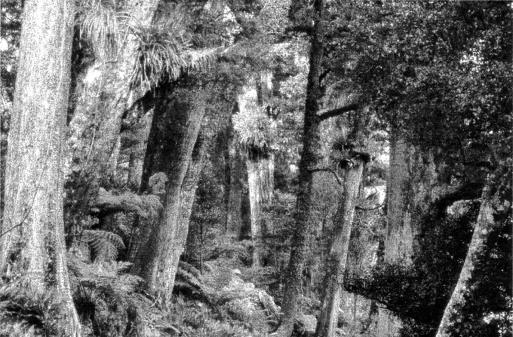 |
| Fig. 1 The massive trunks typical of conifer broadleaf forest: some of these trees can trace their ancestry back to Gondwana. |
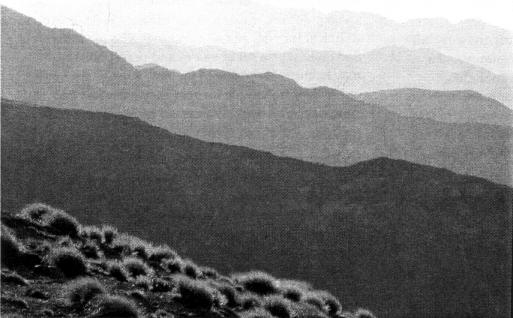 |
| Fig. 2 Alpine snow tussocks and mountain flanks: perhaps the quintessential kiwi experience. |
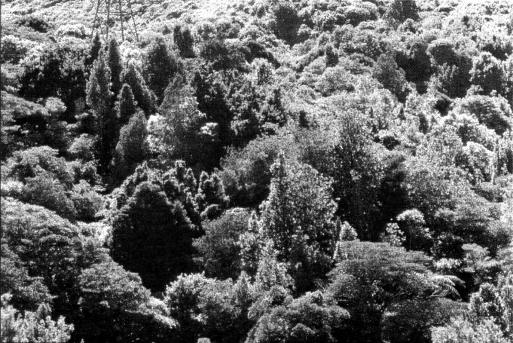 |
| Fig. 3 Wellington's regenerating conifer broadleaf forest, Otari. |
The garden connection
The spirit of wild New Zealand: I doubt that there is a New Zealander cultivating native plants today who is not in some personal way responding to the call of our natural landscapes. For many, perhaps most of us, this has been and remains the basis of our passion for native plants.
But look about our public garden native borders and you will quickly see the basis of my disquiet. Our public native gardens don't rivet the mind or imagination with their reflections of spirit of place and wild New Zealand. On the contrary, they often emanate the virtuous reek of high moral purpose. Who needs aesthetics and spirit if you have high moral purpose? Today, our garden policies and aims focus on plant collections, ecology, botany, horticulture, conservation, protection and education. These may be appropriate strategies for justifying a garden's existence to accountants, politicians, and bureaucrats and (let's be honest) plant enthusiasts. But it doesn't do much for the rest of us.
I suspect that it is not so much that we have lost the plot, but that we have never actually found it. Today our native gardens exist for the benefit of the plants. What nonsense. The plants should exist for the benefit of the garden. Because, as Gertrude Jekyll and other lesser mortals have observed, a collection of plants does not in itself make a garden. And it is high time some of our professional gardeners took this idea to heart.
Michael Pollan has noted in his book, Second Nature, that gardens made by moralists are not as pleasing to the eye as gardens made by aesthetes. I'd go further, because I think that landscape connections and spirit are equally important in the case of the native garden. Our native gardens don't work because they commonly lack two essential elements: aesthetics and connections. Consequently, our native gardens are mundane and boring.
Aesthetics are critical because they provide the stimulus that links the garden with nature. But we don't appear to take them seriously. Over the years we have let the aesthetic dimension slip from our sight and our native borders have suffered accordingly. We make the critical blunder of assuming that things will look good and connect just so long as we grow plants well.
Aesthetics, that level of consciousness we enjoy when our senses are awakened. The importance of the aesthetic response should never be underestimated because it triggers within us a heightened awareness of our immediate surroundings and these, in turn, may reconnect us with long-forgotten events within other landscapes. If we agree that our native gardens should have a serene dimension we need to look carefully at promoting appropriate aesthetic experiences. It is through the aesthetic response that we connect people to the spirit of wild New Zealand within the unique nature of a garden place.
Perhaps our discomfort or ignorance of aesthetics reveals some cultural immaturity in the Kiwi condition. Perhaps, too, this has been strengthened by the assumption that aesthetics are all very well, but really, they are not essential. For it has long been considered that aesthetics are a cultural add-on — only to be taken seriously once other key human and social needs, such as food and shelter, are met.
But current research suggests that this assumption is quite wrong. In fact, scholars now consider aesthetics to have been an integral and essential part of all human cultures. So what are we presently communicating to garden visitors about our Kiwi condition?
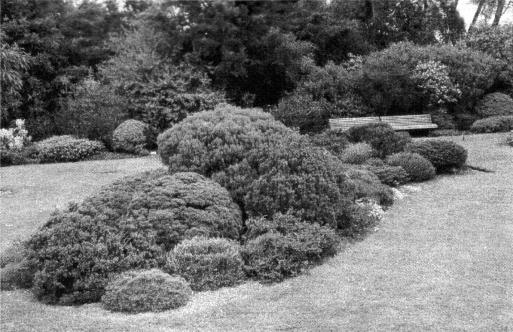 |
| Fig. 4 Cockayne garden, Christchurch with native shrubs arranged in a bed immersed in turf. |
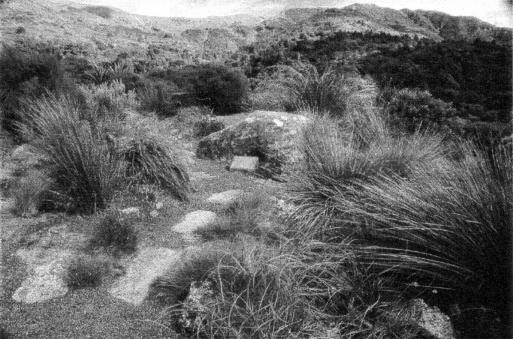 |
| Fig. 5 Otari's climax view of the regenerating forest, from Cockayne's grave. |
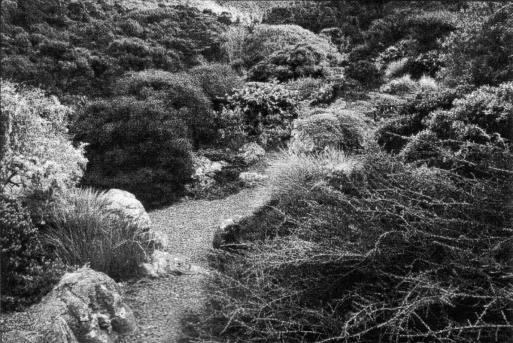 |
| Fig. 6 Brockie's Otari legacy; the rock garden. |
Making connections
It isn't all doom and gloom. During my work on The Native Garden I was fortunate to meet many amateur gardeners imbued with a passion for native plants. To these folk, gardens were as much expressions of past experiences within wild New Zealand landscapes, and of their cultural identity, as they were attractive plant collections. Should this come as a revelation to us? I think not. For throughout human history, plants and landscapes have been imbued with metaphor.
Landscapes don't just mould plants, they also mould the people who live and move within them. Our world view, our sense of national identity, our cultural attitudes and values are all, in part, the product of the landscapes in which we have lived.
Perhaps the most moving account I have read concerning this bond between human culture and home landscape is that written nearly 200 years ago by French explorer Frances Peron. Above the shores of Bass Strait, Peron came upon Australian aboriginal burial monuments on a high hill, carefully positioned to allow panoramic views of sea, coastline and hills. Impressed with their placement, he concluded that these cremated remains had been carefully positioned by the stone-age aboriginals to allow the deceased unrestricted views across this beautiful landscape.
In his foreword to Paul Shephard's book, Man in the Landscape, Michael McCarthy asks: 'What is so strongly felt by the living about views of scenery that they are sanctified as sites for the dead?
Here in New Zealand today we don't express ourselves so strongly, but nevertheless we prize our wild landscapes as places of personal refuge where we can get away from the despair of the daily grind and recharge our batteries. Time out to, as Thoreau suggests, commune with 'higher laws'. Isobel Gabites expressed it more poetically in The Native Garden: 'Our wild places transmit their splendour by osmosis. You just have to be there to soak it up'.
It is not just native landscapes that become our metaphors. Our plants too, have become cultural symbols, icons, supporting our cultural myths, expressing what we think we are or should be. It is surely no accident that the majestic kauri has been planted at our seat of government, enlisted to support our cultural myths of power and permanence. Or consider the cabbage trees that are employed to personify and support Kiwi myths of persistence and survival in the face of great odds or rugged Kiwi self-reliance.
Perhaps the most potent examples are our koru and silver fern. These symbols embrace all New Zealanders; they express and symbolise our national character. Little wonder then, given the special place and potency the koru occupies in our national psyche, that Air New Zealand has seized upon this image to support their branding and marketing strategies.
So, we should never treat our native plants as mere vegetables, or consider them as separate from ourselves or from their landscapes. They are part of us, our national identity, our particular world-view, what makes us special. If we are serious about creating a truly New Zealand native garden we must never reduce our native plants to mere labelled collections, or assume that collections of native plants make a successful garden.
Magic mixes
And at present I'd have to say that amateurs are often expressing it all better than we professionals. Some of the best gardens I visited during my work for The Native Garden were created by people who professed to 'know nothing about gardening'. If this was indeed true (and the ambience and aesthetics of the gardens concerned suggested otherwise) perhaps there is a case for suggesting that we suffer from too much theory and practice and thereby have lost sight of essential spirit and passion. Certainly these amateur gardens had focus and discipline.
Perhaps more significantly, many owners were unequivocal about their passion for local landscapes and their need to 'connect'. Some had even clarified their position. For example, in the New Zealand Gardener (1983), Rob Burton, the owner of one Wellington native garden unequivocally identifies the five tenets of his garden philosophy in an article appropriately entitled 'Patriotism in a Garden is No Mean Thing'. Take note; we have a lot to learn from him:
- Patriotism - devotion to the unique flavour of one's land
- Religious - If God wanted cactus in Karori he would have had them [slightly naughty, here, but a little careful thought will reveal more to this than perhaps we may first credit]
- Unity - this discipline of relating all to time and place
- Practical - local natives solve the discipline of site
- Links to greater surrounds
Other amateur gardeners informally echoed similar sentiments. And, quite independently, here are Isobel Gabites' thoughts on the subject, as expressed in The Native Garden. For her, it is a matter of:
- Kiwi identity
- Local species knowing best
- Compensation for the loss of our heritage, and
- To connect with the magic of wild New Zealand
There is significant agreement here. It's about patriotism (love of what's ours) and Kiwi identity; it's about setting ourselves serenely within our local landscapes; it's about making local connections. But most of all it's about expressing the unique spirit of wild New Zealand. An expression, if you like, of Love of Place. We need to make it ours.
I haven't had the pleasure of hearing similar concepts echoed by gardeners within our public garden system. Perhaps it is about time it happened.
The tragedy is that we are presently so relentlessly focused on horticultural pursuits of high moral purpose that we are in real danger of frittering the vision and passion of those who have gone before us. Take Wellington's Otari Botanic Garden for instance.
Walter Brockie worked at the Otari Native Botanic Garden in Wellington from the late 1940s until the early 1960s. I regard him as one of Otari's unsung heroes. Brockie has constructed what is arguably the best rock garden in the country. You don't need to resort to historical documents to get the essence of this guy - just go and sit in his garden. Brockie obviously loved wild New Zealand and had the flair to communicate this passion through his use of rocks and plants.
But we aren't consistently good at gardening these areas. We fail to hold and develop the original vision. Our patterns, which should strengthen and gel with time, often just fade. We fritter the vision away. What we continue to enjoy at Otari is a legacy; Brockie's rock garden continues to succeed because the original passion and vision was so strong. The spirit we continue to harvest is largely a mixture of Brockie's passion and nature's serendipity. But surely our function should be to make it stronger.
There are two critical lessons to be learnt here and I see the need in nearly all the gardens I visit:
First, the key to ultimate success is in defining a vision and then holding and developing it, through artful maintenance, over time. But we mostly aren't up to it. Further, there appears to be little expectation that this is, in fact, the key skill of the gardeners on site. There is a common misconception amongst us that successful gardens are just a matter of clever plant selection and design. Then, provided the plants are competently planted, watered and fertilised, the vision will take care of itself. Nothing could be further from the truth. The really difficult part is the long slog - the ongoing day-to-day assessment of the garden by skilled gardeners who can assess and manipulate the plant forms in accordance with the dictates of the genius of the site.
Second, we've got to re-evaluate our fascination with new works. Most of the passion I see expended nowadays is in new garden developments. I am not suggesting here that there is anything inherently wrong with pursuing new garden projects, just that they should not be allowed to absorb all our passion and focus. I suspect that this is often the case at present. We expend all our focus and passion on the 'good works'. Meanwhile the rest of the garden goes to rack and ruin.
Our gardeners should be encouraged to develop a strong sense of stewardship and aesthetic sensibility. There's that unfashionable word again. Not everybody denigrates its importance, of course. Our own Dr Leonard Cockayne, who achieved world status as one of the first botanical ecologists, had a unique vision for a national native garden. His passion and efforts were largely responsible for initiating garden developments within Otari in the late 1920s.
Cockayne had no doubts about what was important in a cultivated native garden. In his 1932 publication, a 'Scheme for the Development and Arrangement of the Otari Open Air Native Plant Museum' he makes these points:
'In the arrangement of the species and the general design of the Museum, the first consideration must be beauty'.
And:
'Groups of species, horticultural examples must be as pleasing to the eye as possible'.
And again:
'No horticultural design should be tolerated which is not first class'.
Beauty, aesthetics, design - strong stuff, indeed, coming from an ecologist.
So, what would he make of our present state of gardening expertise? Would our penchant for plonking species randomly into beds or relegating plants to collection pieces and then giving them free reign (apart from the odd desultory trim, plus some prim labelling), meet his approval? I doubt it.
Which raises another question: where do we define what our public gardens should actually look like? OK, we do go so far as to define standards of acceptable tidiness, but that's not the same thing. It's almost as though we assume that our responsibility lies solely in providing well-grown, accurately identified specimen plants free of weeds, pests, plastic wrappers, coca cola cans and other detritus. Our motto is 'Keep them tidy, healthy and let them grow'. Initially we can't see the wood for trees and later, trees for wood. Sometimes, nature benevolently conspires to create something of merit, but mostly we are doomed to watch and weed as our borders slowly degenerate into aesthetic graveyards and structureless chaos.
Our public native gardens must learn to play to a wider audience. They have the potential to become major tourist attractions, provided we can get the messages right - provided our cultivated garden spaces better reflect the spirit of wild New Zealand, our culture and the horticultural potential of our native plants. We should be aiming to develop a global audience, a focus for the cultivation of New Zealand plants within a distinctive New Zealand garden style. For, as I suggested earlier, it's not just tourist potential that's at stake here; it is our international horticultural prestige and credibility.
I can't give you a definitive recipe for success, but I can give some general directions and clues about what can work, what doesn't, and what to avoid.
Towards a New Zealand Garden Style
The spirit of Kiwi garden space
Brockie's rock garden at Otari creates a typical New Zealand rock-strewn environment on a flat site that leads (although presently not inevitably, and that's another shame) to the Otari climax view. Brockie's rocks, the plants and the topography, convey a real sense of wilderness: that special Kiwi mix of sun, wind and sky. Where else could you better direct an overseas visitor intent on experiencing the spirit of New Zealand and our plants in a garden setting? But at present the spirit is squandered by a large, inappropriate and anomalous rectangle of green turf adjacent to the rock garden. Why lawn here? There are much more appropriate ways we could treat this flat plateau and the timorous germs of suitable themes are already present.
Here, at the western edge of this lawn, Cockayne's grave nestles amongst a sadly constricted Wellington coastal plant collection. We miss a great opportunity here to enlarge the rock garden to an appropriate scale and connect it with the coastal planting and Otari's climax view across the cultivated borders to Wellington's conifer broadleaf rain forest behind. Here's a chance to integrate the garden climax themes and create an epic garden statement reflecting Wellington's cultural, botanical, ecological and horticultural history.
Suitable themes abound throughout the Wellington region. Imagine, for example, a local coastal theme incorporating greywacke gravel, with Poa cita spaced in loose drifts and inter-planted with the coastal Raoulia albosericea. Such a theme is infinitely more inspiring and appropriate than European turf grass. It would maintain the strong sense of space and sky and would not interfere with the strong backdrop view to the regenerating forest on the hills beyond.
But let's not restrict our examples to Otari alone. Further afield, there is the Cockayne Garden within the Christchurch Botanic Garden. And guess what, more lawn! It seems such a pathetically inappropriate gesture, to so imprison these plants into their tiny manicured islands, lost in a sea of green. Are we blind? And this in the land of the mighty braided river systems and greywacke mountains! It is almost as though the gardeners and designers of this garden have never ventured further than the city boundaries. Who of us, having wandered the peaks of the Torlesse Range, or boulder-bashed the Rakaia and Waimakariri rivers, could seriously think green?
It would be a more fitting strategy to compose this Christchurch garden landscape in grey and bronze: greys with rocks and raoulias, bronzes with tussocks and spear grasses (aciphyllas). And to include braided riverbed themes, or reflections from the tussock grasslands that dominate large tracts of the eastern South Island. There's plenty of variety and scope. It is time we started to take the native garden landscape (and ourselves) seriously.
Don't tame our tussocks
Talking of grass, if there is one plant that encapsulates the spirit of our high country, it must surely be our snowgrasses. What a wonderful reflection of our landform and mountain environment these tussock plants make. Steep mountain slopes, sunlight, breeze and frothing tussocks; herein lies the spirit of our high country and perhaps the quintessential New Zealand high country experience.
But for some reason the domesticated garden tussock becomes a completely different animal. It is almost as though we completely turn our backs on the experiences that have made us grow plants in the first place. We imprison our tussocks, we demean them in spot plantings around other trees and shrubs, we use them to line the edges of borders, all lined up like toy tin soldiers.
And of course we make worthy collections. Have you ever seen a tussock community or a mountain herbfield resemble a collection of individual species? No fear, and to present these plants in such a fashion is to completely lose the plot. Where is the spirit of our landscapes here? Sadly, like Brier Rabbit, it's got lost in the thicket.
To date we have not come anywhere near using these wonderful plants to their full effect in our gardens. It is not as though we must always plant them in large drifts, although they are very effective when so treated. Coastal landscape patterns incorporating relatively few tussocks teach us that the most important element in a tussock design is the sense of space. This can just as effectively be created by judicious use of a few plants, particularly when used as a foil with sand, coastal or river stones, or larger rock backdrops. There is no need to take my word on this - please get out there and see!
Tangled intentions
New Zealand's native shrublands occur from sea level up to sub-alpine altitudes. They contain dozens of shrub species with horticultural merit. Perhaps the most attractive feature is the wonderful patterns, colours and forms such communities develop as a consequence of individual plants competing amongst themselves for survival in a hostile environment.
But plonk these shrubs into gardens and we have completely different animals. We forget, at our peril, that in nature these plants are regularly pummelled. Strong winds, poor soils, drought and cold act as nature's pruners. Consequently our wonderfully attractive, artfully sculpted and tidily dimensioned shrubs (as seen in nature) may quickly become tangled, formless, malevolent tyrants in the garden border. Released from the bondage of their hostile environment into the civilised garden border, they reward us by rampaging. Unless we are forewarned and diligent with our maintenance, our wonderful shrubland plants may never stop growing and quickly degenerate into formless thickets.
Sadly, garden thickets all too commonly mock our condition, reflecting to the world our lack of vision, discipline and focus. Wherever I go I am confronted by native thickets, created by bumbling enthusiasts who have long since picked up their spades and departed, presumably full of evangelical fervour, to create more vacuous native entanglements elsewhere. Are these the rules of native plant horticulture? That we get to choose the plants, but that they determine the outcome?
I suspect that thickets are the inevitable outcome of growing labels, not plants. Too often, once we have labelled a plant, we no longer see it. But the tendency towards creating thickets in native gardens is insidious and, early on in the life of a border, it is easy to be lulled into a sense of complacency. We need to be aware of the dangers and have our aesthetic concepts and vision well defined. For it's not that thickets cannot be visually pleasant for a brief period, particularly during the first couple of years after planting. The problem is: what are the long-term messages we are conveying here, about these plants, about this special place, this garden? Our gardens are full of these pleasant background borders, reluctantly thrust to centre-stage. We watch and wait for chaos to overwhelm them, our commitment reduced to weeding and hacking, thereby exposing our lack of long-term commitment and vision.
If any shrub is in dire need of garden definition, it is the divaricate. Until now we just haven't had the talent to garden them effectively. It is a good point though - just how should we grow divaricates in gardens? No one has apparently come to grips with it. Yet there is probably no plant form that better expresses the millions of years of isolation, adaptation and evolution our plants have experienced. More than any other, the divaricate encapsulates New Zealand's turbulent icy, cold, dry and windy history.
Most of our divaricates suffer because they are too subtle for us. At first glance these are scrawny, tangled, untidy, dowdy plant forms. I get the feeling that it's the very plasticity of the divaricate form that confuses and confounds us. In nature, pummelling is often the key to their charm, and natural spacing does the rest. They don't get this walloping in our gardens. Worse still, they may be actively cosseted, with tangled, unhappy results.
Epilogue
I'm standing at Cockayne's graveside at Otari, enjoying the late afternoon sunlight that plays across the tops of the regenerating forest on the western hills opposite. It's a great spot. We look out here across the best view for 100 years; the native forest now vigorously regenerating in response to skilled conservation and possum control programmes.
It's not perfect, but it's a big improvement over the destruction Cockayne would have seen. In many ways the future of our native plant communities appears more assured than has been the case for several generations.
But can we say the same for the cultivated areas below me here and at my back? How do you see their future and fate? I suspect that unless we gardeners become more focused and critical in our work toward developing the native garden, these borders are likely to join the ranks of the dinosaurs. Unlike the dinosaurs, they will not expire with a fearful roar, but in silence. They will become extinct because they have been struck dumb; because they no longer communicate any message of cultural significance.
'Our gardens should surely possess a peculiar stamp of their own. Native plants are part of ourselves, they are our very own. That innate patriotism which compels us to feel that our country stands high above all other lands must also make us love its natural characteristics, so that in our gardens of all the (plants) which we cherish, none can ever rank quite as high as those which slowly took shape on New Zealand soils in the far distant past.'
Overdoing it with purple prose perhaps? Don't blame me, that was Leonard Cockayne, writing in 1923.
I think he would be content with the present state of our plant care. But it is surely time now to address what he termed our 'peculiar stamp'. It's time we connected our native garden plants and landscapes with wild New Zealand.
Now that's the spirit!
References
Burton, Robert. (1983) 'Patriotism in a Garden is No Mean Thing.' New Zealand Gardener 40, no 1.
Cartman, Joe. (1996). 'New Zealand Alpines in Gardens.' In J.S. Sheppard and Ann Cartman (eds). Southern Alpines '96: Proceedings of an International Conference. Christchurch: Southern Alpines.
Cockayne, L. (1932). A Scheme for the Development and Arrangement of the Otari Open-Air Plant Museum, and other matters connected therewith. Wellington: Wellington City Council.
Dawson, John. (1988). Forest Vines to Snow Tussocks: The Story of New Zealand Plants. Wellington: Victoria University Press.
Dawson, John, and Lucas, Rob. (1993). Lifestyles of New Zealand's Forest Plants. Wellington: Victoria University Press.
Dawson, John, and Lucas, Rob. (1996). New Zealand Coast and Mountain Plants. Wellington: Victoria University Press.
Gabites, Isobel, and Lucas, Rob. (1998). The Native Garden. Auckland: Godwit Press.
Leach, Helen M. (1994). 'Native Plants and National Identity in New Zealand Gardening: An Historical Review.' In Horticulture in New Zealand, Vol 5.
Otari Native Botanic Garden Management Plan 1996. (1996). Wellington: Policy Unit, Social & Cultural Commissioning, Wellington City Council.
Pollan, Michael. (1996). Second Nature. Bloomsbury Publishing, London
Schama, Simon. (1996). Landscape and Memory. Fontana Press.
Shepard, Paul. (1991). Man in the Landscape: A Historic View of the Esthetics of Nature. Texas: Texas A&M University Press.
Tuan, Yi-fu. (1974). Topophilia, A Study of Environmental Perception, Attitudes and Values. Englewood Cliffs, N.J: Prentice-Hall.
Tuan, Yi-fu. (1993). Passing Strange and Wonderful: Aesthetics, Nature and Culture. Washington, D.C.: Island Press.
Thoreau, Henry D. [1854] (1910). Walden. London: Everyman's Library.
Wilson, Hugh. (1996). 'Southern Alpines: Origins and Mysteries.' In J.S. Sheppard and Ann Cartman (eds). Southern Alpines '96: Proceedings of an International Conference. Christchurch: Southern Alpines.
.
![]()
- View
this paper as a PDF of the original proceedings

- Full
conference proceedings available as a hardcopy from the RNZIH
Reproduced from: New Zealand Plants and their Story
Proceedings of a conference held in Wellington, 1-3 October 1999
ISBN 0-9597756-3-3
Home | Journal
| Newsletter | Conferences
Awards | Join
RNZIH | RNZIH Directory | Links
© 2000–2024 Royal New Zealand Institute of Horticulture
Last updated: April 25, 2004

